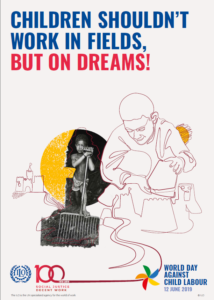Yet today, 152 million children are still in child labour. Although child labour occurs in almost every sector, seven out of every ten is in agriculture.
“Hundreds of millions of girls and boys throughout the world are engaged in work that deprives them of adequate education, health, leisure and basic freedoms, violating their rights. Of these children, more than half are exposed to the worst forms of child labour such as work in hazardous environments, slavery, or other forms of forced labour, illicit activities such as drug trafficking and prostitution, as well as involvement in armed conflict.” (Text taken from ILO website)
Poverty is one of the biggest factors to child labor. Children are sometimes sent or sold into the work force so that a family can put food on the table. Some other factors are things like culture, tradition, lack education and poor enforcement of legislation.
The elimination of child labour is a difficult task because many products, foods and services the world relies on involve some form of it. The international community has identified child labor as a major setback in children’s rights and national development. Progress has been made in the fight to eliminate it all together.
Child labour among girls has fallen by 40% and 25% for boys since 2000. There is still much work to be done to continue to reduce the incidence of child labor around the world.
The UN Sustainable Development Goal Target 8.7 set by the international community is calling for an end to child labour in all forms by 2025.
According to the United Nations, total elimination of child labor requires policies that address poverty. One of the most important policy responses to child labor is education. With little to no access to education, children are often left with no choice but to begin working in exploitative, dangerous jobs.
The elimination of child labor is not a quick fix, but with more awareness, access to education and policies in place, the world can continue to move in the right direction. This day is intended to serve as a catalyst for the growing worldwide movement against child labour. It provides an opportunity to gain support from government, civil society, unions, schools as well as the media and to raise awareness in the campaign against child labour.
Sources and more information
- https://www.we.org/we-schools/program/issues-backgrounders/global-child-labour/
- https://www.ilo.org/ipec/Campaignandadvocacy/wdacl/2019/lang–en/index.htm
- https://www.un.org/en/events/childlabourday/index.shtml
- https://globaldimension.org.uk/child-labour/

